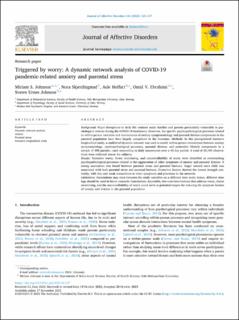| dc.contributor.author | Sinkerud Johnson, Miriam | |
| dc.contributor.author | Skjerdingstad, Nora Paulsen | |
| dc.contributor.author | Hoffart, Asle | |
| dc.contributor.author | Ebrahimi, Omid Vakili | |
| dc.contributor.author | Johnson, Sverre Urnes | |
| dc.date.accessioned | 2024-02-01T08:00:59Z | |
| dc.date.available | 2024-02-01T08:00:59Z | |
| dc.date.created | 2023-11-21T07:47:33Z | |
| dc.date.issued | 2023 | |
| dc.identifier.citation | Journal of Affective Disorders. 2023, 346 329-337. | en_US |
| dc.identifier.issn | 0165-0327 | |
| dc.identifier.uri | https://hdl.handle.net/11250/3114959 | |
| dc.description.abstract | Background: Major disruptions to daily life routines made families and parents particularly vulnerable to psy-
chological distress during the COVID-19 lockdowns. However, the specific psychopathological processes related
to within-person variation and maintenance of anxiety symptomatology and parental distress components in the
parental population have been largely unexplored in the literature. Methods: In this preregistered intensive
longitudinal study, a multilevel dynamic network was used to model within-person interactions between anxiety
symptomatology, psychopathological processes, parental distress, and protective lifestyle components in a
sample of 495 parents—each responding to daily assessments over a 40-day period. A total of 30,195 observa-
tions were collected across the subjects.
Results: Extensive worry, threat monitoring, and uncontrollability of worry were identified as overreaching
psychopathological processes related to the aggravation of other symptoms of anxiety and parental distress. A
strong association was found between parental stress and parental burnout. Anger toward one's child was
associated with both parental stress and parental burnout. Protective factors showed the lowest strength cen-
trality, with few and weak connections to other symptoms and processes in the network.
Limitations: Associations may exist between the study variables on a different time scale; hence, different time
lags should be used in future research. Conclusions: Accessible, low-cost interventions that address worry, threat
monitoring, and the uncontrollability of worry could serve as potential targets for reducing the symptom burden
of anxiety and distress in the parental population. | en_US |
| dc.language.iso | eng | en_US |
| dc.rights | Navngivelse 4.0 Internasjonal | * |
| dc.rights.uri | http://creativecommons.org/licenses/by/4.0/deed.no | * |
| dc.title | Triggered by worry: A dynamic network analysis of COVID-19 pandemic-related anxiety and parental stress | en_US |
| dc.type | Peer reviewed | en_US |
| dc.type | Journal article | en_US |
| dc.description.version | publishedVersion | en_US |
| cristin.ispublished | true | |
| cristin.fulltext | original | |
| cristin.qualitycode | 1 | |
| dc.identifier.doi | 10.1016/j.jad.2023.10.127 | |
| dc.identifier.cristin | 2199184 | |
| dc.source.journal | Journal of Affective Disorders | en_US |
| dc.source.volume | 346 | en_US |
| dc.source.pagenumber | 329-337 | en_US |

